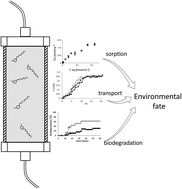Mobility and biodegradability of an imidazolium based ionic liquid in soil and soil amended with waste sewage sludge†
Abstract
Sorption on solids and biodegradation are main phenomena that can mitigate the pollution of soil and water by ionic liquids (ILs). ILs sorbed on soil particles become immobilized (temporarily or permanently) which prevents them from spreading into deeper layers of soil or groundwater but which also makes them less bioavailable. In this study we attempt to examine if amendment of soil with waste sludge has a potential to mitigate the transport and enhance biodegradation of ILs using 1-methyl-3-octylimidazolium chloride ([OMIM][Cl]) as an example. We present the results of adsorption test (batch and column) and ultimate biodegradation of [OMIM][Cl] using microbial communities derived from soil. Finally, we combine all of these processes together to examine the fate of [OMIM][Cl] in a continuous column flow-through system in soil amended with waste sewage sludge. Addition of sludge serves two purposes: firstly increasing soil organic matter (formerly proved to facilitate retardation), and secondly augmenting soil with versatile microbial communities previously shown to successfully degrade ILs.

- This article is part of the themed collection: Waste and Recycling: Sources and Resources

 Please wait while we load your content...
Please wait while we load your content...